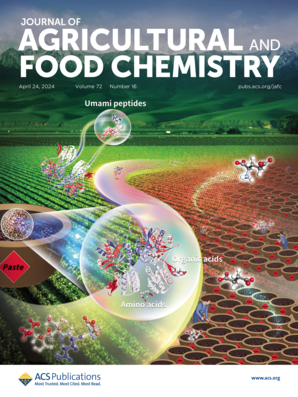Streptomyces sp. NEAU-Y11中两种巴霉素类似物对圆形炭疽菌的抑菌活性及其潜在机制
IF 6.2
1区 农林科学
Q1 AGRICULTURE, MULTIDISCIPLINARY
引用次数: 0
摘要
黄瓜炭疽病是由圆形炭疽菌引起的,严重影响黄瓜产量和品质。本研究从菌株NEAU-Y11中分离得到两种抑菌活性化合物bailomycin C1和JBIR-100,对圆球虫具有较强的抑菌活性,其EC50值分别为0.0491和0.1042 μg/mL,显著低于市售杀菌剂的EC50值(4.42 μg/mL)。盆栽试验结果表明,巴霉素C1和JBIR-100在0.2 μg/mL和0.4 μg/mL浓度下可有效防治黄瓜炭疽病,效率分别达到78.5%和67.7%。显微镜和生化分析表明,这两种化合物破坏了真菌细胞壁、细胞膜和氧化还原稳态,导致细胞死亡。转录组分析进一步揭示了巴菲霉素C1 's对氨基酸代谢、细胞结构、氧化还原稳态和DNA双链断裂修复的影响。这些结果表明,巴霉素C1和JBIR-100是一种很有前景的农化杀菌剂,可作为开发下一代抗真菌药物的基础。本文章由计算机程序翻译,如有差异,请以英文原文为准。

Antifungal Activity and Potential Mechanisms of Two Bafilomycin Analogues Isolated from Streptomyces sp. NEAU-Y11 against Colletotrichum orbiculare
Cucumber anthracnose, caused by Colletotrichum orbiculare, severely affects the cucumber yield and quality. In this study, two active compounds, bafilomycin C1 and JBIR-100, were isolated from strain NEAU-Y11 and exhibited strong antifungal activity against C. orbiculare, with EC50 values of 0.0491 and 0.1042 μg/mL, respectively, significantly lower than those of the commercial fungicide (4.42 μg/mL). Pot experiments demonstrated effective control of cucumber anthracnose at 0.2 μg/mL for bafilomycin C1 and 0.4 μg/mL for JBIR-100, with efficacies reaching 78.5 and 67.7%, respectively. Microscopy and biochemical analyses indicated that both compounds disrupted the fungal cell wall, membrane, and redox homeostasis, leading to cell death. Transcriptome analysis further revealed the effects of bafilomycin C1′s on amino acid metabolism, cell structure, redox homeostasis, and DNA double-strand break repair. These findings suggest that bafilomycin C1 and JBIR-100 are promising candidates for use as agrochemical fungicides to control C. orbiculares and may serve as a basis for developing next-generation antifungal agents.
求助全文
通过发布文献求助,成功后即可免费获取论文全文。
去求助
来源期刊
CiteScore
9.90
自引率
8.20%
发文量
1375
审稿时长
2.3 months
期刊介绍:
The Journal of Agricultural and Food Chemistry publishes high-quality, cutting edge original research representing complete studies and research advances dealing with the chemistry and biochemistry of agriculture and food. The Journal also encourages papers with chemistry and/or biochemistry as a major component combined with biological/sensory/nutritional/toxicological evaluation related to agriculture and/or food.

 求助内容:
求助内容: 应助结果提醒方式:
应助结果提醒方式:


